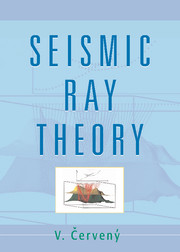Book contents
- Frontmatter
- Contents
- Preface
- 1 INTRODUCTION
- 2 THE ELASTODYNAMIC EQUATION AND ITS SIMPLE SOLUTIONS
- 3 SEISMIC RAYS AND TRAVEL TIMES
- 4 DYNAMIC RAY TRACING. PARAXIAL RAY METHODS
- 5 RAY AMPLITUDES
- 6 RAY SYNTHETIC SEISMOGRAMS
- APPENDIX A FOURIER TRANSFORM, HILBERT TRANSFORM, AND ANALYTICAL SIGNALS
- References
- Index
1 - INTRODUCTION
Published online by Cambridge University Press: 03 February 2010
- Frontmatter
- Contents
- Preface
- 1 INTRODUCTION
- 2 THE ELASTODYNAMIC EQUATION AND ITS SIMPLE SOLUTIONS
- 3 SEISMIC RAYS AND TRAVEL TIMES
- 4 DYNAMIC RAY TRACING. PARAXIAL RAY METHODS
- 5 RAY AMPLITUDES
- 6 RAY SYNTHETIC SEISMOGRAMS
- APPENDIX A FOURIER TRANSFORM, HILBERT TRANSFORM, AND ANALYTICAL SIGNALS
- References
- Index
Summary
The propagation of seismic body waves in complex, laterally varying 3-D layered structures is a complicated process. Analytical solutions of the elastodynamic equations for such types of media are not known. The most common approaches to the investigation of seismic wavefields in such complex structures are (a) methods based on direct numerical solutions of the elastodynamic equation, such as the finite-difference and finite-element methods, and (b) approximate high-frequency asymptotic methods. Both methods are very useful for solving certain types of seismic problems, have their own advantages and disadvantages, and supplement each other suitably.
We will concentrate here mainly on high-frequency asymptotic methods, such as the ray method. The high-frequency asymptotic methods are based on an asymptotic solution of the elastodynamic equation. They can be applied to compute not only rays and travel times but also the ray-theory amplitudes, synthetic seismograms, and particle ground motions. These methods are well suited to the study of seismic wavefields in smoothly inhomogeneous 3-D media composed of thick layers separated by smoothly curved interfaces. The high-frequency asymptotic methods are very general; they are applicable both to isotropic and anisotropic structures, to arbitrary 3-D variations of elastic parameters and density, to curved interfaces arbitrarily situated in space, to an arbitrary source-receiver configuration, and to very general types of waves. High-frequency asymptotic methods are also appropriate to explain typical “wave” phenomena of seismic waves propagating in complex 3-D isotropic and anisotropic structures. The amplitudes of seismic waves calculated by asymptotic methods are only approximate, but their accuracy is sufficient to solve many 3-D problems of practical interest.
Asymptotic high-frequency solutions of the elastodynamic equation can be sought in several alternative forms.
- Type
- Chapter
- Information
- Seismic Ray Theory , pp. 1 - 6Publisher: Cambridge University PressPrint publication year: 2001
- 1
- Cited by



